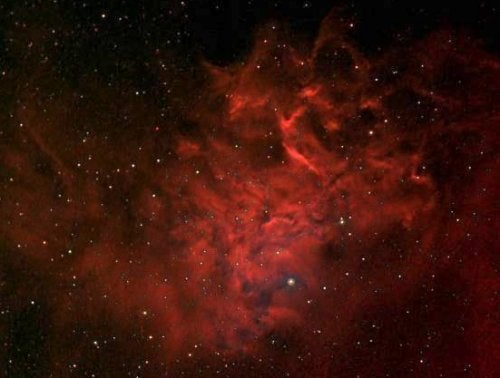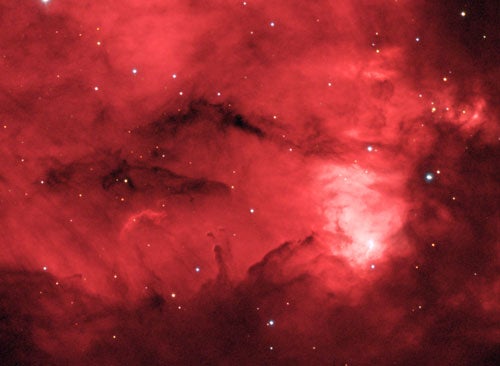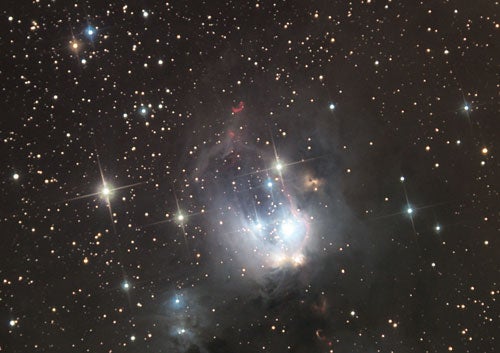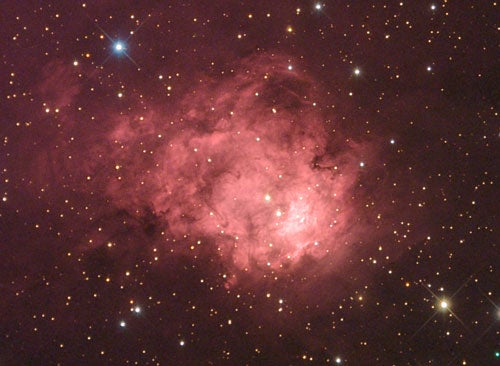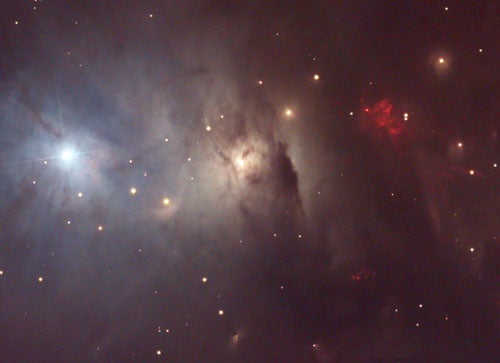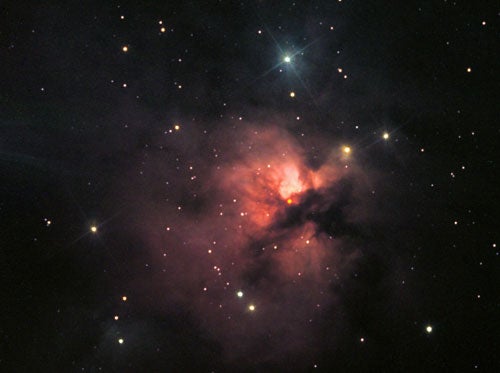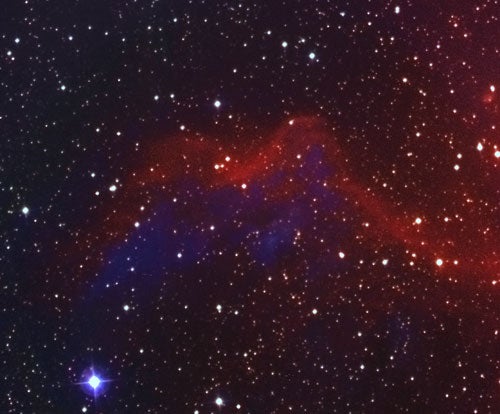IC 405 (left) is lit up by the energetic star AE Aurigae embedded within it. But AE Aurigae wasn’t born in this cloud of gas and dust.
It’s story is more complex and linked to another star more than 65° away — Mu (μ) Columbae. Some 2.7 million years ago, these two stars formed in Orion Nebula. Somehow, AE Aurigae and Mu Columbae made a close pass to one another and found themselves accelerated so greatly that they shot out of the Orion complex. The celestial runaways came to astronomers’ attention by their rapid motion across the sky; backtracking their courses revealed their common origin.
Of the pair, AE Auriga is notable because of its current environs; by illuminating a nebula, this escapee becomes a “Flaming Star.”
NGC 896 and IC 1795 glow in Cassiopeia. Faint hydrogen emission — caused by starlight energizing the gas — occurs throughout the region and well beyond this image. NGC 896 is the brightest portion. Dark nebulae are also visible in this image. Dusky lanes trace thick ribbons of dust where stars may be forming today.
NGC 7129 in Cepheus contains bright stars some astronomers think may be less than a million years old. In their youth, stars emit lots of ultraviolet radiation and often exhibit violent stellar winds. Saturated in the energetic photons, the surrounding gas begins to glow, while each star’s outflow of particles carves out a cavity around it.
One edge of a new-formed cavity (right of the bright central stars) glows pink from excited hydrogen emission. A few red structures mark regions where star formation is occurring, but the dense cloud still screens the infant stars from our view.
NGC 7538 lies in Cepheus near its border with Cassiopeia. At a distance of 9,800 light-years, NGC 7538 is one of the most studied star-formation regions in our galaxy. At least three compact infrared components, invisible here, accompany the visible nebulosity. Some studies have revealed cavities etched in the dense molecular gas surrounding the infrared sources, which are likely newborn stars.
The density of gas and dust in NGC 1333, located in Perseus about 720 light-years away, creates different optical effects. Light of the brightest star (left) is tinted blue, which indicates the light is scattered toward us after interacting with dust particles. Fainter stars barely show through the fringes of the thick, opaque molecular cloud. Infant protostars have carved out cavities and blown out shells of gas. Reds and pinks, the fingerprint of excited hydrogen gas, show where these young stars are active.
If you find yourself missing summertime’s Trifid Nebula (M20), give NGC 1579 in Perseus a look. The nebula glows both from hydrogen emission (red) and light scattered by the cloud’s thick dust (blue).
Gazing at this nebula with instruments sensitive to heat instead of light would show a brilliant glow and many young stars the dust hides from view. In fact, the 2MASS infrared survey allows us to do exactly this. Click here to see how different NGC 1579 looks when viewed at longer wavelengths.
The bright bluish star Gamma (γ) Cassiopeiae illuminates this ribbon of red and blue emission astronomers call IC 59; the star itself is out of frame at the top. The cloud’s starward edge glows strongly in the flood of radiation. In fact, IC 59 and another nearby shred of cloud known as IC 63 (not shown) represent the last phase of a nebula’s existence. Both will continue to dissipate until they lose all individual identity, merging with the sparse dust and thin gas astronomers call the interstellar medium.

